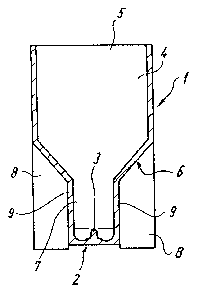Une partie des informations de ce site Web a été fournie par des sources externes. Le gouvernement du Canada n'assume aucune responsabilité concernant la précision, l'actualité ou la fiabilité des informations fournies par les sources externes. Les utilisateurs qui désirent employer cette information devraient consulter directement la source des informations. Le contenu fourni par les sources externes n'est pas assujetti aux exigences sur les langues officielles, la protection des renseignements personnels et l'accessibilité.
L'apparition de différences dans le texte et l'image des Revendications et de l'Abrégé dépend du moment auquel le document est publié. Les textes des Revendications et de l'Abrégé sont affichés :
| (12) Brevet: | (11) CA 2090263 |
|---|---|
| (54) Titre français: | RECIPIENT DE MESURAGE |
| (54) Titre anglais: | MEASURING VESSEL |
| Statut: | Périmé et au-delà du délai pour l’annulation |
| (51) Classification internationale des brevets (CIB): |
|
|---|---|
| (72) Inventeurs : |
|
| (73) Titulaires : |
|
| (71) Demandeurs : |
|
| (74) Agent: | SMART & BIGGAR LP |
| (74) Co-agent: | |
| (45) Délivré: | 2003-01-07 |
| (22) Date de dépôt: | 1993-02-24 |
| (41) Mise à la disponibilité du public: | 1993-08-26 |
| Requête d'examen: | 1999-12-17 |
| Licence disponible: | S.O. |
| Cédé au domaine public: | S.O. |
| (25) Langue des documents déposés: | Anglais |
| Traité de coopération en matière de brevets (PCT): | Non |
|---|
| (30) Données de priorité de la demande: | ||||||
|---|---|---|---|---|---|---|
|
A measuring vessel for holding liquids such as blood,
blood plasma, or the like that are to be analyzed. The
measuring vessel incorporates a shaft that is of rectangular
cross-section. One end of this shaft forms an inlet opening
and the opposite end area is formed as a funnel that opens out
into a tubular section. The tubular section incorporates at
least two parallel side surfaces that extend to almost the whole
length and the end of the tubular section is closed off by a
bottom. The wide sides of the shaft that extend parallel to
each other each form a flat contact surface. There is a part
of foot elements connected with the tubular section on which
the measuring vessel can be stood. The bottom of the tubular
section is formed with a circular internal base area and a
central stud which foams a track for a ball with the help of
which the coagulating characteristics of blood can be measured.
Note : Les revendications sont présentées dans la langue officielle dans laquelle elles ont été soumises.
Note : Les descriptions sont présentées dans la langue officielle dans laquelle elles ont été soumises.

2024-08-01 : Dans le cadre de la transition vers les Brevets de nouvelle génération (BNG), la base de données sur les brevets canadiens (BDBC) contient désormais un Historique d'événement plus détaillé, qui reproduit le Journal des événements de notre nouvelle solution interne.
Veuillez noter que les événements débutant par « Inactive : » se réfèrent à des événements qui ne sont plus utilisés dans notre nouvelle solution interne.
Pour une meilleure compréhension de l'état de la demande ou brevet qui figure sur cette page, la rubrique Mise en garde , et les descriptions de Brevet , Historique d'événement , Taxes périodiques et Historique des paiements devraient être consultées.
| Description | Date |
|---|---|
| Inactive : CIB de MCD | 2006-03-11 |
| Le délai pour l'annulation est expiré | 2005-02-24 |
| Lettre envoyée | 2004-02-24 |
| Accordé par délivrance | 2003-01-07 |
| Inactive : Page couverture publiée | 2003-01-06 |
| Inactive : Taxe finale reçue | 2002-10-15 |
| Préoctroi | 2002-10-15 |
| Un avis d'acceptation est envoyé | 2002-04-15 |
| Un avis d'acceptation est envoyé | 2002-04-15 |
| Lettre envoyée | 2002-04-15 |
| Inactive : Approuvée aux fins d'acceptation (AFA) | 2002-04-04 |
| Modification reçue - modification volontaire | 2002-02-13 |
| Inactive : Dem. de l'examinateur par.30(2) Règles | 2001-10-15 |
| Modification reçue - modification volontaire | 2000-05-18 |
| Lettre envoyée | 2000-01-25 |
| Inactive : Renseign. sur l'état - Complets dès date d'ent. journ. | 2000-01-25 |
| Inactive : Dem. traitée sur TS dès date d'ent. journal | 2000-01-25 |
| Exigences pour une requête d'examen - jugée conforme | 1999-12-17 |
| Toutes les exigences pour l'examen - jugée conforme | 1999-12-17 |
| Demande publiée (accessible au public) | 1993-08-26 |
Il n'y a pas d'historique d'abandonnement
Le dernier paiement a été reçu le 2002-02-25
Avis : Si le paiement en totalité n'a pas été reçu au plus tard à la date indiquée, une taxe supplémentaire peut être imposée, soit une des taxes suivantes :
Veuillez vous référer à la page web des taxes sur les brevets de l'OPIC pour voir tous les montants actuels des taxes.
| Type de taxes | Anniversaire | Échéance | Date payée |
|---|---|---|---|
| TM (demande, 5e anniv.) - générale | 05 | 1998-02-24 | 1998-02-05 |
| TM (demande, 6e anniv.) - générale | 06 | 1999-02-24 | 1999-02-04 |
| Requête d'examen - générale | 1999-12-17 | ||
| TM (demande, 7e anniv.) - générale | 07 | 2000-02-24 | 2000-02-24 |
| TM (demande, 8e anniv.) - générale | 08 | 2001-02-26 | 2001-02-07 |
| TM (demande, 9e anniv.) - générale | 09 | 2002-02-25 | 2002-02-25 |
| Taxe finale - générale | 2002-10-15 | ||
| TM (brevet, 10e anniv.) - générale | 2003-02-24 | 2003-02-04 |
Les titulaires actuels et antérieures au dossier sont affichés en ordre alphabétique.
| Titulaires actuels au dossier |
|---|
| HEINRICH AMELUNG GMBH |
| Titulaires antérieures au dossier |
|---|
| ROLF AMELUNG |